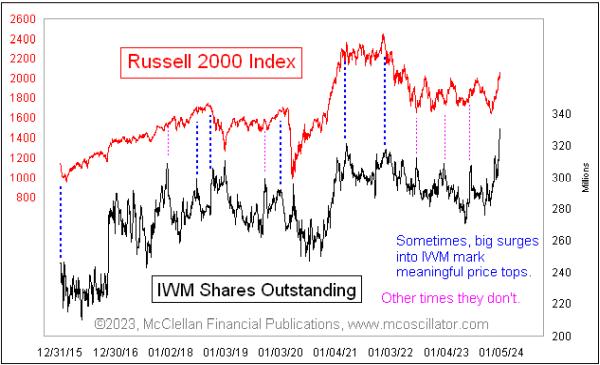
The Russell 2000 Index has been performing quite well lately, rising 26% since the Oct. 27 low. This has resulted in a lot of performance chasing, with traders piling into IWM, the iShares Russell 2000 Index ETF. Part of that performance chasing has meant a big surge in the number of shares outstanding of IWM.
An ETF is different from a closed end fund (CEF), in that an ETF can expand or contract the number of shares in existence as needed to meet demand and keep the net asset value (NAV) close to the share price. More shares outstanding means more traders want to own it.
A lot of the time, a big surge in IWM shares outstanding like this is a great marker of a price top. But there are quite a few instances when a big surge in shares outstanding occurs without a big price move to help explain it, which I have noted with the pink-dashed vertical lines. Those instances are harder to explain. There have even been spikes in shares outstanding occurring as prices fall, as with the one at the bottom of the 2020 COVID Crash.
It does appear that when a big surge in shares outstanding occurs simultaneous with a price surge, that more accurately marks a topping condition. But remember that a condition is not a signal, and there is no telling just from this observation of a spike in shares outstanding when this condition is going to decide to matter.
One question which comes up when noticing the rise in the number of IWM shares outstanding is whether this inflow into that ETF (and thus into the stocks it holds) is driving the up move in the Russell 2000 Index. But the total value of all of those shares outstanding in IWM is only about 1% of the market capitalization of all the Russell 2000 stocks, so it is not much of a factor.
Any indication of trader sentiment can offer us a useful message about sentiment swinging too far, if read correctly. In the case of IWM and its number of shares outstanding, there are traders who can be induced to buy when they see positive performance. But at some point, all who can be convinced to buy will have done so, and so there are no more marginal buyers left to fuel further gains. But how much of a move into IWM is exhaustive?
A sentiment survey such as AAII, NAAIM, or Investors Intelligence bulls vs. bears has bounded values. In other words, there can never be more than 100% bulls or 100% bears, and sentiment can only swing just so far. An indication like the number of shares outstanding in an ETF is not bounded in this way, and thus it can be difficult for us to declare when it has gone far enough to provide a compelling indication. And even if all the hot money has bought, so that there is none left, a trend can still continue until that hot money (and other money) gets a hint that the music is about to stop playing, and they start pulling money back out again.
